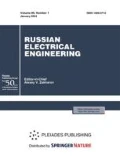Abstract
A generalized method of design is developed, and structural diagrams and functional dependencies of basic types of electric devices (EDs) with levitation elements (LEs) are systemized. Their main technical indices are considered. The concepts of inductive levitation coefficients and force rate are introduced, and their optimal values are found. It is found that, at the time of connection of excitement winding to a power supply source, the currents flowing along the winding and the levitation element are much higher than the rated values. However, the losses in the levitation element sharply increase, whereas the heat emissions increase only a little, with all the energy released in the levitation element being used to heat it. As a result, the LE may melt in the initial phase of motion and fail to reach a steady state. The analytical equation for the inductive levitation coefficient is obtained as q function of the magnet core dimensions and the coefficient of force rate, physical and technical characteristics of the LE material, and preset overheating temperature. A mathematical model based on the parameters of current and force regimes is developed, in which the equations of magnetic, electric, mechanical, and thermal circuits of the magnetic system are included. From this model, the dimensionless quantities and main dimensions of the magnetic system are calculated. For copper and aluminum LEs, numerical values of dimensionless quantities are calculated, and on their basis reference tables necessary for designing EDs with LEs are compiled. The derived analytical equations for the main dimensions take into account preset winding overheating temperature, input and output parameters, and the condition of the uniformity of the magnetic field in the working air gap. The optimal magnet core dimensions are determined at which the perimeter of the cross section of the middle core is minimal. At the same time, the active resistance of the excitement winding and the levitation element will also be minimal, which will minimize active capacity losses.
Similar content being viewed by others
References
Abdullaev, Ya.R., Teoriya magnitnykh sistem s elektro-magnitnymi ekranami (The Theory of Magnetic Sys-tems with Electromagnetic Screens), Moscow: Nauka, 2000.
Abdellayev, Y.R., Piriyeva, N.M., and Kerinzade, O.O., Methods of reduction of the stepped induction levita-tors active power losses, Proc. 9th Int. Conf. “Technical and Physical Problems of Electrical Engineering”, Istan-bul, Sept. 9–11, 2013.
Abdullaev, Ya.R., Mamedova, G.V., and Kerimzade, G.S., The way to calculate multi-nominal AC stabilizers with levitation winding and with direct magnetic circuit, Elektromekhanika, 2007, no. 1, pp. 27–34.
Author information
Authors and Affiliations
Corresponding author
Additional information
Original Russian Text © Ya.R. Abdullayev, G.S. Kerimzade, G.V. Mamedova, N.M. Piriyeva, 2015, published in Elektrotekhnika, 2015, No. 5, pp. 16–22.
About this article
Cite this article
Abdullayev, Y.R., Kerimzade, G.S., Mamedova, G.V. et al. Design of electric devices with induction levitation elements. Russ. Electr. Engin. 86, 252–257 (2015). https://doi.org/10.3103/S1068371215050028
Received:
Published:
Issue Date:
DOI: https://doi.org/10.3103/S1068371215050028



